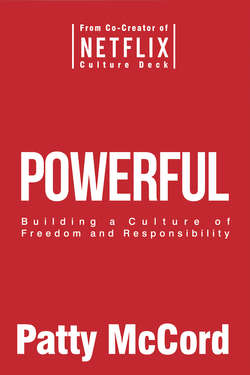Читать книгу Powerful - Patty McCord - Страница 6
INTRODUCTION
A New Way of Working | Foster Freedom and Responsibility |
ОглавлениеIn an executive meeting one day at Netflix, we suddenly realized that in nine months we would account for a third of U.S. Internet bandwidth. We had grown around 30 percent a quarter for three quarters in a row. At the time, we were still thinking that we might eventually be as big as HBO, but not for many years. Our head of product did a quick calculation of how much bandwidth we’d need in a year if we maintained our current growth rate. He then said, “You know, that would be a third of U.S. Internet bandwidth.” We all just looked at him and blurted out in unison, “WHAT?” I asked him, “Does anyone at the company know how to make sure we can manage that?” He answered, with the honesty we always hoped for, “I don’t know.”
In my fourteen years on the executive team at Netflix, we constantly faced such daunting growth challenges, sometimes existential ones, and in technologies and services that we were pioneering. There was no playbook; we had to make it up. From the moment I joined Netflix, when the company had barely launched, the nature of our business and our field of competitors evolved continuously and incredibly rapidly. Our business model, the technology that drove our services, and the teams of people we needed in order to execute had to do more than keep pace—we had to anticipate changes and proactively strategize and prepare for them. We had to hire stellar talent in whole new areas of expertise and fluidly reconfigure our teams. We also had to be ready at any moment to cast aside our plans, admit mistakes, and embrace a new course. The company had to perpetually reinvent itself—first figuring out how to keep our DVD-by-mail business thriving while simultaneously throwing ourselves into learning how to stream; then moving our systems to the cloud; then beginning to create original programming.
This book is not a memoir of the building of Netflix. It is a guide to building a high-performance culture that can meet the challenges of today’s rapid pace of change in business, written for team leaders at all levels. Netflix may be an especially stark example, but all companies, from start-ups to corporate behemoths, must become great adapters. They need the ability to anticipate new market demands and to pounce on remarkable opportunities and new technologies. Otherwise, the competition will simply innovate faster. Now that I am consulting with companies all over the world, from large blue chips like J. Walter Thompson to fast-growth newcomers like Warby Parker, HubSpot, and India’s Hike Messenger, as well as a number of fledgling start-ups, I see the wider landscape of challenge vividly. It’s striking how similar—and pressing— the fundamental problems are. Everybody wants to know the same thing: how can they create some of their own Netflix mojo? More specifically, how can they create for themselves the kind of nimble, high-performance culture that has made Netflix so successful? That’s what this book is about: how you can draw on the lessons that we learned at Netflix and apply the principles and practices we developed to managing your own team or company.
Did we do everything right at Netflix? Not by a long shot. We had plenty of stumbles, some very public. And we didn’t have a big aha moment about how to meet our challenges; we evolved a new way of working through incremental adaptation: trying new things, making mistakes, beginning again, and seeing good results. Ultimately, we created a distinctive culture that supports adaptability and high performance. I am not going to claim that tackling the challenges of rapid change is easy in any way or for anyone. The good news is that we found that inculcating a core set of behaviors in people, then giving them the latitude to practice those behaviors—well, actually, demanding that they practice them—makes teams astonishingly energized and proactive. Such teams are the best drivers to get you where you need to go.
I’ve laced the book with stories about how we met challenges at Netflix, in part to make the book a lively read but also because they show how the methods we developed can be implemented. You will find the book somewhat unconventional—which, I hope you’ll agree, is appropriate for a book that is largely about defying convention. One of the pillars of the Netflix culture is radical honesty, something I have loved since I was a small child growing up in straight-talking Texas. If you watch any of my talks that are posted online, you’ll see that it’s my way to speak freely, and I’m going to do so here. Please think of reading this book like engaging in a lively debate. You may be annoyed by some of what I say and find yourself pushing back on certain points. I hope you’ll also find yourself nodding emphatically in agreement with others. As I learned through many intense debates at Netflix, nothing is quite as much fun as a free-flowing intellectual sparring match, and I very much want reading this book to be fun.
